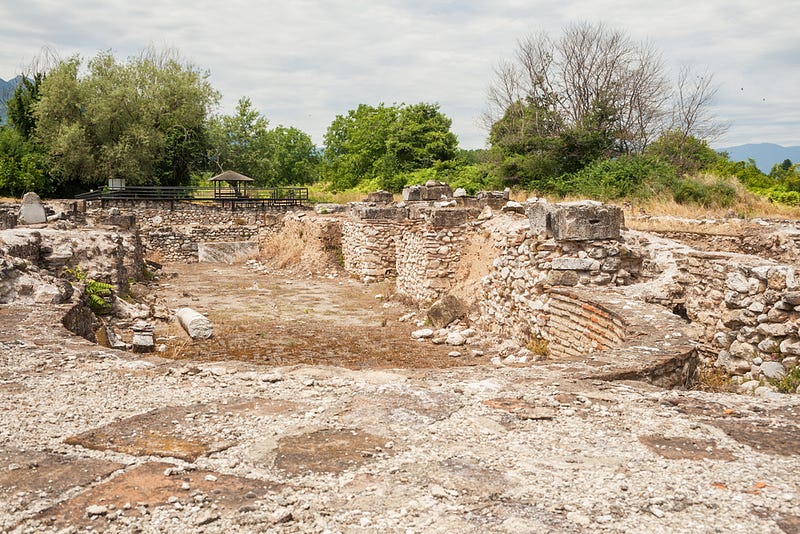Life in Ruins
By Heather Welch, Environmental Science, 2020

A skull here, a coin there, the foundations of an ancient home — the study of archaeology reveals to modern societies how their long gone counterparts lived and related. In 2019, a recently discovered site in Idaho inspired a study, which postulated that the first people who arrived on the American continents did so at least 16,000 years ago by boat. But how do artifacts and structures, such as the ones that provided this information, survive hundreds to thousands of years until someone luckily happens upon them?
Remains such as pottery, paintings, buildings, and bones are, in fact, often broken or damaged when discovered by archaeologists. Many natural processes, including sunshine, precipitation, animal interference, and bacterial breakdown, can jeopardize the condition of artifacts. However, some factors can improve the chances of surviving erosion, rust, rot, and warp.
A few processes, including deposition of sediments from floods or volcanic eruptions, can preserve materials by providing a protective layer. This phenomenon infamously occurred in the Italian city of Pompeii, which was destroyed in A.D. 79, and rediscovered in the mid-18th century. The fine-grained volcanic ash produced by the tremendous volcanic explosion encased the city so tightly that archaeologists have been able to unearth intact glass jars still containing fruit. Pompeii’s intricate and colorful interiors were so well-preserved that, upon their discovery, their portrayal further inspired the revival of neoclassical art and architecture in Europe.
A few processes, including deposition of sediments from floods or volcanic eruptions, can preserve materials by providing a protective layer.
Another factor that impacts the longevity of historical artifacts is the material composition. Wood may rot quickly, and mudbrick often crumbles. Stone structures generally withstand the test of time with greater success, as do some metals. In many cases, processes used to make pottery are integral to material longevity. Petra, one of the world’s oldest and most culturally significant archaeological sites, remained preserved for thousands of years partially due to its structural usage of the Jordanian environment. Archaeologists found Petra carved into the landscape’s red sandstone rocks, surrounded by protective mountains that helped the city remain undiscovered and undisturbed by humans. However, the ancient structures still face threats from ongoing erosion, flash flooding, and tourism.
The environment in which an archaeological site exists also affects the extent to which the site is buried and preserved. The composition and thickness of the topsoil layer, as well as its rate of accumulation, have a large impact on how quickly a site is buried, and what reactions the material may have with biological factors. The Inachos River watershed in Greece was the subject of a study that proposed a statistically significant relationship between surface erosion and artifact distribution. The conductors of the study further postulated that mountainous and semi-arid regions, like the Inachos River watershed, are particularly vulnerable to erosion. Subsequent soil loss affects the elements and processes to which the artifacts and structures are exposed. Soil accumulates quickly on a floodplain as water deposits sediment that gradually settles in the flooded areas. In sand dunes, blowing sands rapidly bury ancient sites. The Great Sphinx, excavated in the early 1900s, required experts to painstakingly uncover the monument from massive amounts of Egyptian sand.
The composition and thickness of the topsoil layer, as well as its rate of accumulation, have a large impact on how quickly a site is buried, and what reactions the material may have with biological factors.
When a new civilizations rises, remains of the old civilization (e.g. foundational structures, family belongings, city waste) may be buried underneath and protected by the layers conveniently built on top of them. The famous tells of the Middle East, known as artificial mounds of mudbrick and societal refuse reaching up to 30 meters high, were formed in this way. The mounds formed when successive generations living in the same area accumulated layers of crumbled mudbrick over thousands of years. Essentially, cities and settlements have constantly been abandoned, knocked down, and then covered by new structures. In the past, the foundations and rubbish of previous civilizations often remained due to the inability to effectively remove them. Thus, cities eventually raised their elevations as new generations built over old.
It remains to be seen what will be built upon this generation when it fades away.
Science (2019). DOI: 10.1126/science.365.6456.848
Journal of Field Archaeology (2018). DOI: 10.1080/00934690.2018.1518947